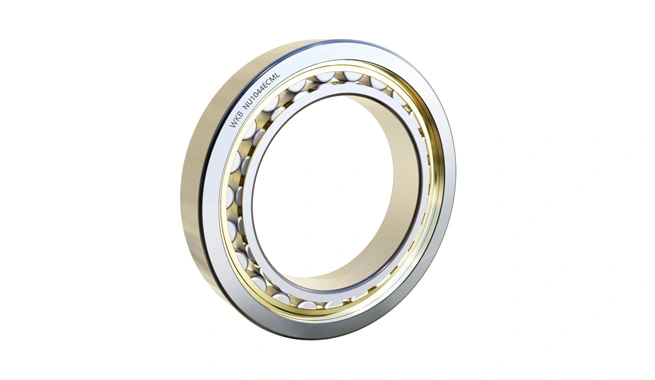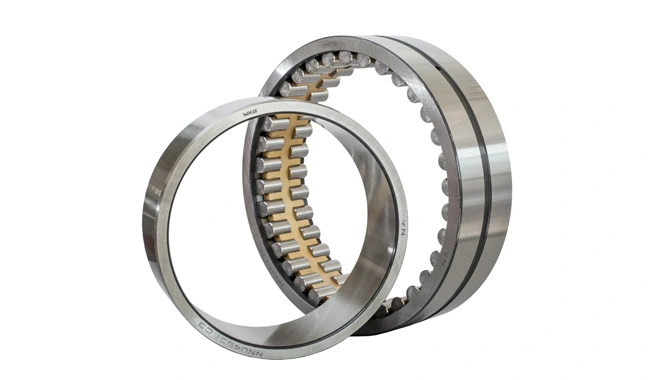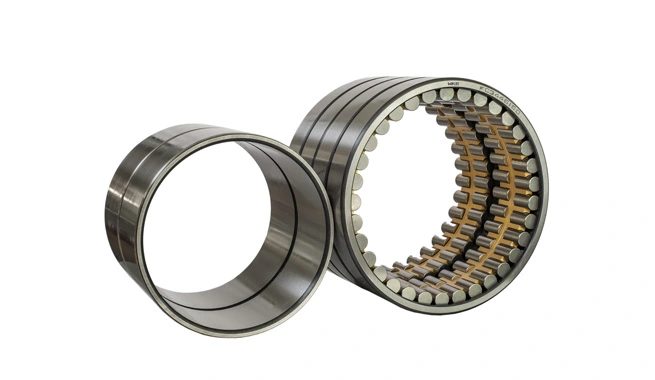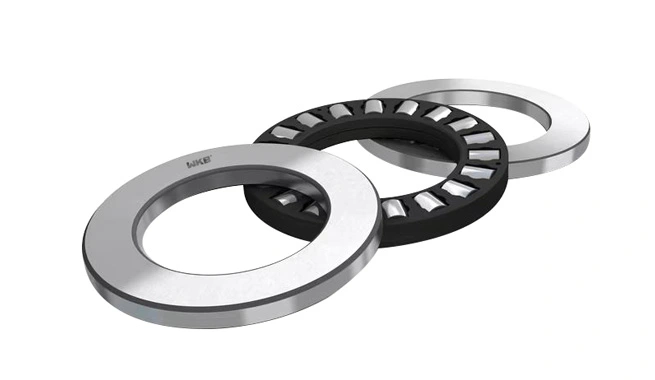Cylindrical roller bearings are the unsung heroes in countless machines, keeping things spinning smoothly while handling hefty loads. Whether it’s a massive wind turbine or a zippy conveyor belt, these bearings are designed to take on serious radial forces with minimal fuss. But what exactly are they, how do they work, and why should you care? Let’s dive into the world of cylindrical roller bearings, explore their types, applications, and why they’re a go-to choice for engineers everywhere.
Cylindrical roller bearings are a type of rolling-element bearing that uses cylindrical rollers—think tiny barrels—instead of balls to reduce friction between moving parts. These rollers sit between an inner and outer ring (called races) and make line contact with the raceways, spreading the load over a larger surface area. This design gives them a superpower: they can handle heavy radial loads (forces perpendicular to the shaft) better than most other bearings, like ball bearings.
Why They’re Special: Unlike ball bearings, which have point contact, cylindrical rollers offer line contact, making them ideal for high-load, high-speed applications. They’re also versatile, coming in various designs to suit different needs, from single-row to multi-row setups.
Picture a cylindrical roller bearing as a team of rollers working together to keep a shaft spinning smoothly. The rollers are guided by a cage (or retainer) to prevent them from bumping into each other, reducing friction and wear. The inner ring fits onto the rotating shaft, while the outer ring sits in a housing. As the shaft turns, the rollers roll along the raceways, distributing the load evenly.
Key Mechanics:
· Line Contact: The cylindrical shape creates a line of contact with the raceways, allowing the bearing to handle heavier radial loads than ball bearings.
· Axial Capability: Some designs (like NJ or NUP types) can handle limited axial (thrust) loads in one or both directions.
· Separable Design: Many cylindrical roller bearings have separable inner and outer rings, making them easy to install or remove.
Insight: The line contact design is what makes cylindrical roller bearings so robust, but it also means they’re more sensitive to misalignment than spherical roller bearings. Proper alignment is key to maximizing their lifespan.
Cylindrical roller bearings come in several flavors, each tailored for specific applications. Here’s a quick rundown:
· Single-Row Cylindrical Roller Bearings: The most common type, with one row of rollers. They’re separable, making mounting and dismounting a breeze. Examples include NU (no ribs on inner ring) and NJ (one rib for axial load in one direction).

· Double-Row Cylindrical Roller Bearings: Two rows of rollers for higher radial load capacity. Used in precision applications like machine tool spindles.

· Four-Row Cylindrical Roller Bearings: Heavy-duty champs for roll-neck applications in steel mills, handling extreme loads.

· Full Complement Cylindrical Roller Bearings: No cage, packed with more rollers for maximum load capacity but higher friction. Ideal for low-speed, high-load scenarios.
· Cylindrical Thrust Roller Bearings: Designed for axial loads, often used in heavy machinery like extruders.

Table: Types of Cylindrical Roller Bearings
Type | Features | Common Applications |
Single-Row | Separable, moderate load capacity | Electric motors, gearboxes |
Double-Row | Higher load capacity, precision | Machine tools, compressors |
Four-Row | Extreme load capacity | Steel mill roll-necks |
Full Complement | Maximum load, higher friction | Cranes, heavy machinery |
Cylindrical Thrust | Handles axial loads | Extruders, drills |
Cylindrical roller bearings are workhorses in industries where heavy loads and high speeds are the norm. Here are some key uses:
· Industrial Machinery: Gearboxes, pumps, and compressors rely on these bearings for smooth operation under heavy radial loads.
· Automotive: Found in transmissions and wheel hubs, handling both radial and some axial loads.
· Wind Turbines: Their high load capacity makes them ideal for gearbox and main shaft applications.
· Railways: Used as wheelset bearings for trains, supporting heavy loads at high speeds.
· Steel Industry: Four-row bearings shine in roll-neck applications, handling massive loads in rolling mills.
· Aerospace: Precision bearings support high-speed, high-load components in aircraft engines.
Insight: The global bearing market is projected to reach $199.2 billion by 2026, with cylindrical roller bearings playing a big role due to their versatility in heavy-duty applications. Choosing the right type can make or break your equipment’s performance.
Wondering how cylindrical roller bearings stack up against ball bearings? It’s all about design and purpose:
· Contact Area: Cylindrical rollers have line contact, distributing loads over a larger area, while ball bearings have point contact, limiting their load capacity.
· Load Capacity: Cylindrical roller bearings handle heavier radial loads, making them ideal for industrial applications. Ball bearings are better for lighter loads and higher speeds.
· Speed: Ball bearings have lower friction, suiting high-speed applications like electric motors. Cylindrical rollers can handle high speeds but are better for moderate-speed, high-load scenarios.
· Misalignment: Ball bearings, especially self-aligning types, tolerate misalignment better than cylindrical roller bearings, which require precise alignment.
Table: Cylindrical Roller Bearings vs. Ball Bearings
Feature | Cylindrical Roller Bearings | Ball Bearings |
Contact Type | Line contact | Point contact |
Load Capacity | High radial loads | Moderate radial, axial loads |
Speed | Moderate to high | High |
Misalignment Tolerance | Low | Moderate (self-aligning types) |
Common Uses | Gearboxes, wind turbines | Electric motors, fans |
Insight: If your application involves heavy radial loads, like in a steel mill, cylindrical roller bearings are your best bet. For high-speed, lighter-load setups, like a small motor, ball bearings are the way to go.
Why choose cylindrical roller bearings? Here’s what makes them stand out:
· High Radial Load Capacity: Their line contact design handles heavy radial loads better than ball bearings.
· High-Speed Capability: Despite higher friction than ball bearings, they’re suitable for high-speed applications with proper lubrication.
· Separable Design: Many types allow easy mounting and dismounting, saving time during maintenance.
· Versatility: Available in single, double, or multi-row designs to suit various applications.
· Durability: Made from alloy or high-carbon steels, they resist fatigue and shock loads when properly maintained.
Insight: Proper lubrication is critical for cylindrical roller bearings, especially full complement types, to minimize friction and heat. Oil lubrication often doubles as a coolant, extending bearing life.
Here are key takeaways for anyone considering cylindrical roller bearings:
· Precision Matters: Misalignment can shorten bearing life, so ensure proper shaft and housing alignment during installation.
· Lubrication is Key: Use oil or grease suited to your application’s speed and load to prevent wear and overheating.
· Future Trends: Advances like ceramic hybrid cylindrical bearings are boosting performance in high-precision applications like aerospace.
What are cylindrical roller bearings?
Cylindrical roller bearings use cylindrical rollers to reduce friction and support heavy radial loads. They consist of inner and outer rings, rollers, and a cage, with designs like single-row, double-row, or full complement.
What is the difference between spherical and cylindrical roller bearings?
Spherical roller bearings have barrel-shaped rollers and a spherical outer raceway, allowing self-alignment and handling of both radial and axial loads. Cylindrical roller bearings have straight rollers, excel at radial loads, but are sensitive to misalignment.
What are the advantages of cylindrical roller bearings?
They offer high radial load capacity, moderate to high-speed capability, separable design for easy installation, and durability under heavy loads when properly lubricated.
What are cylindrical roller bearings used for?
They’re used in gearboxes, wind turbines, railway wheelsets, steel mills, and automotive transmissions, handling heavy radial loads in demanding conditions.
What are the types of cylindrical roller bearings?
Types include single-row (NU, NJ), double-row, four-row, full complement, and cylindrical thrust bearings, each suited for specific load and speed requirements.
How do cylindrical roller bearings compare to ball bearings?
Cylindrical roller bearings handle heavier radial loads due to line contact, while ball bearings suit lighter loads and higher speeds due to point contact.
Why are cylindrical roller bearings preferred for high-load applications?
Their line contact design distributes loads over a larger area, and robust materials like high-carbon steel ensure durability under extreme conditions.
· BMC Bearing. (2020). What are Cylindrical Roller Bearings and How are They Used?
· Ritbearing Corporation. (2019). What Are Cylindrical Roller Bearings.
· ScienceDirect. (n.d.). Cylindrical Roller Bearings - An Overview.
· Tameson. (2022). How to Choose the Right Cylindrical Roller Bearings.
· Tameson. (2023). Ball vs Roller Bearings.
· Machine Design. (2015). What’s the Difference Between Bearings?
· Koyo Bearings. (2019). What Are the Differences Between Bearings?
· NSK Americas. (n.d.). Cylindrical Roller Bearings.
· GlobalSpec. (n.d.). Cylindrical Roller Bearings Selection Guide.
· Emerson Bearing. (2018). What Are Roller Bearings?